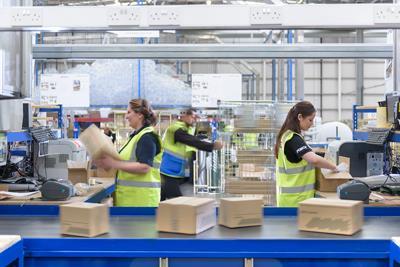
iForce is one of the leading efulfilment specialists in the UK, working for blue chip clients including John Lewis, Tesco.com, Sainsbury’s and Fortnum & Mason.
The boom in online retailing has seen the company grow fast, not least because it has developed a highly effective returns operation to maximise the value from a troublesome part of the supply chain that can end up being a drain on resources rather than a valuable asset.
iForce group sales director Geoff Taylor says: “We've had quite good growth in the last couple of years, with 30% increases in turnover year on year. That's forecast to continue for the next few years.”
The company employs 750 in ten leased sites with 1.6m ft2 of warehousing space. “That's a mixture of sites run for sole or multiple clients,” says Taylor. “What's becoming more common is that we implant our services into retailers’ own facilities, such as in our recent win Maplin.”
Electronics retailer Maplin recently appointed iForce to manage its warehousing, and an iForce team has set up shop at Maplin’s site in Rotherham , south Yorkshire to manage its store replenishment, online ordering and click and collect operations.
“Our solution was to implant our technology and our know-how into their facility,” says Taylor. “That's always an interesting proposition, because one day an employee's wearing a Maplin top and the next day he's wearing iForce.
Tricky
“That process is tricky and you need really good employee engagement and to make them feel part of the iForce family. We spend a lot of time getting people to buy into what we're looking to achieve. It's not the first time we've done that. We did that a couple of years ago for [fashion retailer] Cath Kidston at their St Neots facility and more recently for Fortnum & Mason in Sutton [near Cambridge].”
Like everyone in the logistics sector, one of iForce’s biggest challenges is coping with peak trading.
“Our workforce goes from 750 to about 2,500 during peak,” says Taylor. “Resource management is absolutely critical. How can you make sure you're getting the quality that you need, in order to deliver your clients’ service? They will go through a two-day training program and pass a test before they go onto the shop floor.
“It's quite an intensive program but we need to ensure we get the right quality people. It's really tricky to get it right because we have to manage our client's cost at the same time. Having over resources does nothing for your cost so we've got to get that balance right.”
Taylor explains that there are in effect two peaks for any season. “Inbound is the first, so we start to build up resources with agency labour for the flood of inbound volume. We then start topping that up for the outbound peak as that starts.”
iForce was at the vanguard of online retail order fulfilment, and it sent out John Lewis's first ever online order, 14 years ago.
“Sending out their first order is something we're very proud of,” says Taylor. “Now they're a £1.5bn online retailer.”

While iForce has always been focused on e-fulfilment, it has been able to grow with its retail clients as they have sought to use common stock to fulfil all of their sales channels.
“With Maplin and Cath Kidston, we are fulfilling their store replenishment orders as well as online, international or whatever their channels may be,” says Taylor. “That's how we've evolved and we are now despatching around 35 million items a year from that part of our business. That's pretty impressive volume.”
One issue facing retailers with both bricks and mortar stores and a big online presence is that the ideal pack sizes and formats are often different for each channel, making it more complex to serve both from the same warehouse.
“It really depends on how the store wants to receive the items,” says Taylor, “and whether they want to get packs, cases or single items. As a principle we try to consolidate stock into big locations, so you get good density and use the warehouse much more effectively.
“It can be either a case pick or it can be singles but we try and condense them down to as few locations as possible and pick from the same location, regardless whether it's a store or an online order.”
Efficient use of space
This approach is not just more cost effective – it also allows far more efficient use of warehouse space.
“When we first got involved with Cath Kidston, they were looking at moving out of their existing warehouse because they were bursting at the seams,” says Taylor. “Once we got in we recognised that it wasn't the cube of the building that was a problem, it was the stock management.
“Four years later, they are still in the same building. They've extended their range and deferred that capital expense. They were able to use that money to open more stores and get more revenue into the business. Our service delivery isn't just about getting the order out. It's much more complicated than that.”
A second significant part of iForce’s business is processing returns to extract the maximum value from returned goods as quickly as possible. Its site at Saltley near Birmingham handles 10 million returned items a year for Tesco, Screwfix, and House of Fraser.
“The overall objective of our processing is to give the retailer visibility and traceability of what's actually happening to their item,” says Taylor. “The key element really is how you can deploy your resources to recover as much value from that return as possible.
“For every pound we spend, we recover £15 for our clients. About 63% of the items we receive will eventually go back onto the shelf, to be sold again. Whatever you can do with that item to get it back on that value train is really important.
“It's a really important part of the retail environment. The best retailers can add 0.5% onto their net margin by effectively managing returns. It's a big opportunity for retailers to take cost out of their supply chain.”
Repairs
While returning unwanted, undamaged items to the supply chain is relatively easy, iForce has developed workshop capacity to repair damaged items such as bicycles to extract some value from them.
“In the past, that particular retailer might have chosen to destroy that returned bike,” says Taylor. “If, by refurbishing those bikes, we can get them back into pristine condition they can go back on that shelf to be resold. For that operation, for every pound we spend, we recover £43.
“Of course, many of our retail clients have a return to vendor agreement that enable that returned item to go back to the vendor. It's our job to fulfil that vendor's requirements in terms of how they receive the items. Do all those particular lines have to go onto one pallet or can they be mixed up and so on.
“Then it's our job to hunt down the suppliers to get them in here to collect their stock again, for the benefit of our retail clients.”
Because of the range of clients’ returns handled at Saltley, the operatives employed there have to have a wide range of skills to quickly assess the products as they arrive and decide on the best course of action (see box – Aladdin’s cave).
“We see things from kettles, TVs, clothes, cement mixers and everything in between,” says Taylor. “We’ve got to have a very broad range of skills to deal with all these products.”
For products that cannot be made fit to go back into the retailer’s supply chain, but are still in saleable condition, iForce has set up its own online auction site, iForce Marketzone.
“That is a platform to enable us to sell either pallets of mixed or single items, which aren't good enough to be sold as pristine but have still got a significant value attached to them,” says Taylor. “We'll use that mechanism to dispose of those items effectively but importantly, you're drawing upon a market that enables you to recover as much value for those items as you can.
“Long gone are the days where retailers should be relying on jobbers to rock up in their expensive cars and pay 10p in the pound for stock. You got to deploy more intelligence to recover better value out of these type of products. The typical shoppers on iForce Marketzone will be buying a couple of pallets, breaking them down in their garages and then selling the items on eBay.
“They are a kind of modern day car booter really. They're paying more than somebody who is going buy 24 pallets. You are attracting the right type of people who are paying more for that mixed pallet of grade B or grade C stock.”
Third party transport
Despite operating from eight sites around the UK iForce does not operate any of its own transport as it does not need trunk product between centres and all its outbound volumes is via third party carriers.
“We don't move product between sites because each site is retailer orientated,” says Taylor. “For outbound volume to consumers we use carriers and a transport network will be delivering it to stores.
“If you take Cath Kidston, where we're servicing over 100 of their stores, and that will be through our chosen transport provider. The vehicles go from our DC straight to the stores. There's no kind of hub and spoke system. It's all direct deliveries from our facilities.”
While some of these deliveries will be full trailer loads, the consignment size means they can go on 7.5 tonners.
“We are into regular replenishment, rather than huge replenishment once a week,” says Taylor. “We also deliver into cities as well.”
The growing popularity of click and collect means that around 35% of orders now go to physical stores rather than to a consumer’s home address. For stores like John Lewis, these click and collect orders can go via the retailer’s own RDC store delivery network or direct to store by carrier, depending on when the order is received.
iForce’s retailer customers are responsible for delivering stock to its fulfilment centres to ensure it has the right stock to meet the flow of orders coming through the ecommerce sites.
“We will proactively help retailers to manage us, in terms of frequency of delivers, in order to reduce costs,” says Taylor. “We help retailers to manage their dead or very slow moving stock as well, which might take up 15% of the warehouse space,
“Stock management is really important. Our principle really is get your stock management right and everything else will follow.”
NDC model
The NDC model is well suited to online retailers as well as those with a bricks and mortar estate who can use their own distribution systems to top up iForce’s sites.
“If you take Cath Kidston and Maplin, or that type of model, we are the only DC for their business,” says Taylor. “We receive full containers direct into us. There isn't kind of a staging process at all, where we're pulling off three pallets at a time. We're getting that stock in, all at the same time.
“With John Lewis, for example, where we have a very large facility in Redditch, they have got their own supply chain, so they are replenishing us like a typical RDC from their main DCs. That model's different to a single DC operation for a retailer, where we are receiving those direct deliveries all the time.
“The models are different but the technology is the absolute fundamental part of what we do. We use our know-how and expertise to deploy that technology effectively, in order to manage the client’s stock and high service level requirements.
“We typically review costs with our retailers every week. That's a key part of our operating procedures and enables the retailers to have confidence in how we're performing from a cost perspective. You may have hit all your service KPIs but if you're over-spending by 25%, there's an issue.”
Software is the genie in the lamp
As well as handling the physical products, key to a successful operation is keeping the retailers’ inventory management systems up to date with accurate data. iForce has developed its own bespoke software, Route Genie, which it is selling to third party logistics firms to create a third revenue stream.
“Whether it is fulfilment or returns, technology is the key driver,” says Taylor. “That technology is wholly owned by us. That enables us to be agile and quick to respond to clients’ requirements as their proposition changes.
“For many years, carrier management software was provided to our iForce logistics clients by another provider. As a part of our package, we'll be providing our clients with the ability to route orders to particular carriers. We decided two years ago to invest significantly in our technology to improve functionality, and out of that Route Genie was born.”
Route Genie, iForce Pathfinder’s software, is designed to provide a retailer with better visibility on progress with their orders. As well as selecting the best carrier based on the weight and size of the consignment, it also provides a higher level of transparency of how a carrier is performing and at what cost.

“The dashboard is the significant part of the product,” says Taylor. “That has gone extremely well. It's a really important part of our evolution as a business. We see software as a service application, which Route Genie is, as being something we'll continue to add to, as our business becomes more mature.
“There are still many retailers – maybe 40% - that don't have a carrier management system at all. They still have direct integrations with carriers themselves. That's been a real surprise to me. I think the City Link scenario has worried an awful lot of retailers relying on their own direct integrations. They need flexibility to be able to switch quickly.”
iForce has also developed its own software to manage order fulfilment, called Smart, that handles stock management and inventory control, and a similar system for returns, called Rescue.
An Aladdin’s cave of returns
A walk around the Saltley returns handling site is like entering an Aladdin’s cave of unwanted products, where a small army of operatives work to retrieve as much value as possible from the 20,000 products a week it processes.
The site processes all the returns for Screwfix and all non-food returns for Tesco. The ideal outcome for any returned item is that it is deemed to be resellable, and non-electrical items that have been returned because they are unwanted or the delivery failed are returned to store to be put back on shelf.
The operatives act like triage nurses in a busy A&E department – quickly assessing whether a product can go back into stock, can be repaired and sold through iForce’s online auction site, has to go back to the supplier, or – the last resort – is in such poor shape it has to be disposed of as waste.
Even waste can have some value – the copper windings in power tools can be retrieved and sold, for example, so even waste products are separated into streams depending on their value. As a result there is no cost associated with waste disposal – it is self-funding.
For Tesco Wine, iForce makes up ‘lucky dip’ cases of mixed wines from damaged returns, which are sold via Tesco’s website at attractive prices.
In a corner of the facility, two skilled technicians repair damaged bicycles, sometimes cannibalising parts from other returned bikes. These can then be repackaged and returned to the retailer or sold through iForce Marketzone.
There is a secure cage for high value items such as mobile phones and games consoles. Each manufacturer has a different policy for returns which iForce must adhere to – Nintendo for example will take back products which are faulty but not those that are just not wanted by the buyer, while Apple insists on getting back returns with seven days of receipt.














